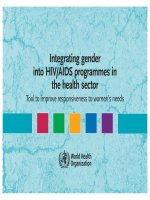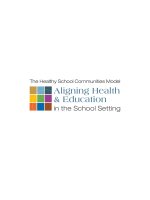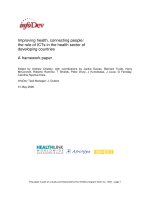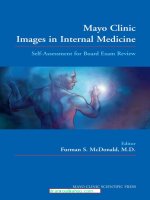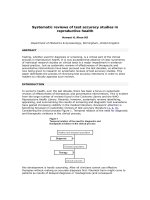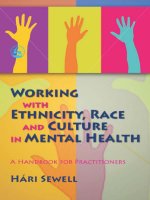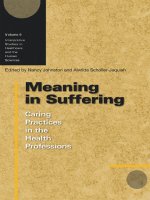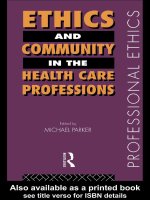Competency-based education in the health professions: Implications for improving global health doc
Bạn đang xem bản rút gọn của tài liệu. Xem và tải ngay bản đầy đủ của tài liệu tại đây (332.54 KB, 25 trang )
1
Competency-based education in the health professions:
Implications for improving global health
Larry D. Gruppen, Ph.D
1
., Rajesh S. Mangrulkar, M.D
2
., Joseph C. Kolars, M.D.
2
Departments of Medical Education
1
and Internal Medicine
2
, University of Michigan Medical
School
Improvements in global health can only be realized through the development of a
workforce that has been educated to promote health and to care for those with disease. Increased
attention is being placed on competency-based education as a means for optimizing the
preparation of health professionals. The purpose of this paper is to describe the characteristics of
competency-based education (CBE) and how this can be distinguished from the more traditional
approaches to training health professionals. An approach to the implementation of CBE will be
reviewed along with a discussion on implications for resource poor regions of the world.
Competency-based education
Competency-based education is a framework for designing and implementing education
that focuses on the desired performance characteristics of health care professionals. Although
this has always been the implicit goal of more traditional educational frameworks, CBE makes
this explicit by establishing observable and measureable metrics that learners are expected to
accomplish. The ability to perform to established expectations is the criteria by which a health
professional is deemed competent.
Alternative, but complimentary, goals have more traditional educational frameworks
have been on learning outcomes or objectives.
1-6
In a seminal article, Epstein and Hundert
2
established a commonly cited definition of competency in health care: “Competency is the
2
habitual and judicious use of communication, knowledge, technical skills, clinical reasoning,
emotions, values, and reflection in daily practice for the benefit of the individual and the
community being served.” Note that this definition includes any and all possible results of the
educational process. It also emphasizes that these results are used or applied as part of regular
practice – not as an exceptional performance.
The terms learning outcomes, or outcomes-based education, are often used synonymously
with CBE. However, “competencies” often carries with it a broader, more conceptual
connotation of what the learner is able to do as a result of the education whereas “outcomes” is
often used in reference to the performance on exams and other metrics that document the
learning that has taken place
“Learning objective” is another term that has some overlap with “competency.” Well-
written learning objectives can be competency based if the objective is to have the learner
performing in a real world task. More often, “learning objectives” are used to describe the
knowledge that teachers are hoping that students will acquire from their curriculum or teaching
exercise.
Albanese et al.
7
propose five characteristics to define a competency:
1. A competency focuses on the performance of the end-product or goal-state of
instruction
Traditional education tends to focus on what and how learners are taught and less so on
whether or not they can use their learning to solve problems, perform procedures, communicate
effectively, or make good clinical decisions. By emphasizing the results of education rather than
its processes, CBE provides a significant, even dramatic shift in what educators and policy-
makers look for in judging the effectiveness of educational programs. Figure 1 illustrates the
3
differing levels of educational goal states. For early learners, outcomes at the level of “knows”
and “knows how” may be sufficient, but for more advanced learners, educational goals are more
typically at the levels of “shows” and “does.” In CBE, the critical issue is that the learner reaches
the specified level of performance in a competency; how he or she got to that point (the
educational process) is secondary.
Figure 1
Miller‟s Pyramid
8
2. A competency reflects expectations that are external to the immediate
instructional program
Traditional educational programs too often have an insular character in which the
expectations of learners are based on what has been taught with internal, educational metrics of
4
success such as performance on a standardized exam. In CBE, success is determined by the
ability to perform to expectations that are largely determined by stakeholders outside of the
educational program itself.
3. A competency is expressible in terms of measurable behavior
Although traditional education does assess learner knowledge and progress, CBE places a
much higher premium on learner performance of tasks and activities representative of the
competencies. These assessments are more than just paper-and-pencil tests of knowledge; they
emphasize behavioral measures that depend on integrating knowledge and skills derived from an
aggregate of educational experiences and parts of the curriculum.
4. A competency uses a standard for judging competence that is not dependent
upon the performance of other learners
Each performance assessment of competence must be accompanied by an explicit criteria
for determining whether or not a given learner has or has not attained the required level of
performance to be considered “competent.” These criteria or performance standards are not
determined by the performance of other learners (i.e., not graded on a „curve‟) but by the expert
judgment of practitioners and educators in the field. Thus, it is desirable that ALL learners will
achieve “competence” after training.
5. A competency informs learners, as well as other stakeholders, about what is
expected of them
By focusing on the outcomes of education, CBE is often much more transparent and
therefore accountable to learners, policy-makers and other stakeholders. Indeed, defining a
discipline‟s values, goals and priorities is an implicit part of defining competencies, which
5
enables the competencies to communicate these values and expectations to various stakeholders
within and outside the discipline.
In addition to Albanese, et al.‟s five characteristics of “competencies,” two other terms
often used in discussions on educational frameworks warrant a clear definition. “Assessment” is
integral to CBE and refers to any of a wide variety of measurements of learner performance.
CBE‟s emphasis on learner performance as evidence for having achieved a competency is
predicated on the ability to accurately and validly measure performance in tasks and situations
reflective of that competency.
“Standard” refers to the actual threshold or level of performance in a given assessment
that, in the judgment of relevant stakeholders, constitutes an acceptable or targeted level of
achievement. “Standard,” in its CBE definition is integrally tied to the judgment that someone is
“competent,” i.e., has reached an acceptable level of performance on a designated competency.
In this usage, “standard” refers to learner performance and contrasts with the frequent use of
“standard” in reference to a “standard curriculum” and even a “standardized examination.”
Defining the curriculum for competency-based education.
The curriculum, or what is to be learned, is at the heart of all educational models. It is the
genesis or origin of the curriculum that differentiates traditional models from CBE. Historically,
the professions themselves have set requirements that serve to determine who can obtain
membership based on completion of curricula that they determine. While often positioning
themselves to serve the public good, there is also a tendency to serve the needs of their own
professions and members. Curricula often become anchored to historical legacies that codifies
the traditions, priorities, and values of the faculty in that profession. Over time, the curricula are
modified with new information. Typically, this is additive with less attention to the removal of
6
elements that are less pertinent to current practice. Often, it is the expansion of new scientific
knowledge that drives the curriculum, at the expense of a focus on the implementation of what is
already known to be of benefit.
In addition, traditional curricula may or may not have explicitly defined objectives or
purposes. Although there has been a greater focus on the need for learning objectives in the
health professions, it is not uncommon for schools to „retrofit‟ the objectives to reflect what the
faculty desire to teach. In this sense, the curriculum drives the objectives rather than the desired
learning objectives driving the curriculum (see Figure 2). This framework then results in a
system of assessment that is again based on the mastery of a curriculum that may be detached
from the needs of society.
7
Figure 2
Comparing traditional and competency-based educational models
A systematically different approach to the design of curricula will be required that provides
greater alignment with what society needs from those that are responsible for its health. These
health care needs should drive the performance standards, or desired competencies, of health
care professionals, which in turn should determine the curricula by which will result in the
achievement of competency. More recently, input from stakeholders representing the public
good have become more involved in seeking better alignment between the goals of professional
education and the needs of society. For example, the United States National Board of Medical
Examiners, which is responsible for the licensing of all graduating physicians in the U.S., has
adopted a plan to realign its licensure processes to more substantially reflect the expectations of
patients.
9
When comparing CBE to some of the more traditional models of education (Fig. 2), three
fundamentally different characteristics emerge. First, CBE explicitly maps the specific health
needs of the populations to a set of competencies for the workforce to be trained. In other words,
it guides decisions about what graduates of the educational programs must be able to do, in order
to address the key health issues of the community. Second, CBE uses these expectations to then
develop and implement learning experiences (the curriculum) designed to produce the requisite
knowledge values, and skills in the learners to achieve these competencies. Finally, CBE uses the
same set of competencies to develop critical assessment programs to determine the extent to
which they are reached.
8
The practical steps in implementing a competency-based educational system
The past five years have seen an acceleration in the development of competencies in
different health professional fields, including medicine, nursing, midwifery, and public health.
Many of these efforts have been driven by the professional organizations themselves, in an
attempt to define expected knowledge, skills and behaviors of graduate practitioners. While
making important contributions, many fall short of a fully implemented CBE model often
because of a focus on learning objectives that do not align with how a true competency is
defined.
Common pitfalls to the establishment of CBE are as follows: (1) they fail to directly
address the health needs of the community, (2) competencies are inadequately defined or to
broad to be useful, (3) a lack of accommodation in the curriculum for the flexibility in learning
rates and (4) the lack of assessment methods to determine when competency has been achieved.
.
1. Defining the health needs of the community
A CBE program has the potential to improve the health of the community it serves only
to the extent that it uses context specific health issues to determine the desired competencies.
Needs assessments that portray available health data along with input from the community and
those responsible for public health are necessary to inform this process.
A multitude of approaches could be considered. In Australia, for example, the provincial
government struggled to change the health outcomes for key chronic diseases for remote, rural
and Indigenous populations. However, using a training needs analysis drawn from interviews
with key informants consisting of practitioners, local policy makers, and the staff of regional
clinics, an organizational partnership of universities, health departments and Indigenous
9
organizations implemented a competency-based curricular framework targeted at multiple cadres
of health providers to address prevention and early detection of these key chronic conditions.
10
Alternatively, a curricular improvement model was implemented that involved the direct
observation of graduates from nursing midwifery school in practice along with a survey of these
practitioners regarding their perceived needs to better serve the for the community and the gaps
that they recognized in their own training.
11
The data was then used to define competencies and
outcomes that would guide the subsequent curricular revision in family planning, reproductive
and child health.
Other efforts have stepped back from direct sampling, and have used multilateral expert
panels to attempt to indirectly represent the health of communities within which they work. For
example, at a global scale, The Millennium Development Goals could be considered one of the
largest efforts to define shared public health goals, with quantifiable targets for health set among
several clinical domains, drawn from a large international community of public health providers,
practitioners and organizations.
12
It has been proposed that the development of any Global
Health core competencies should begin by addressing these specific targets. More recently, in
2006 the Association of Schools of Public Health in the U.S. embarked on a national consensus-
building process to identify core competencies for the Master‟s in Public Health degree. The
project used a structured two-phase process with input from over 400 university faculty
members, deans, public health organizations, and practitioner organizations.
13
Implemented over
two years, the effort resulted in specific competencies within 12 different domains that have been
disseminated widely.
There are intrinsic advantages with explicitly addressing the health needs of society in
any competency development effort. First, such a fully implemented CBE system and assessment
10
program provides outcome variables that can be mapped to desired changes in health. Second,
the programs then become accountable to all relevant stakeholders, including patients, health
providers, and governments. Finally, learners working within this system become accountable as
well, to their own performance measures and how they measure up to the health expectations of
society.
2. Defining competencies
The central step in shifting from a traditional to a competency-based educational
framework is to define the target competencies for the specified set of learners. These
competencies reflect specific goals of education, but also express institutional or national policy,
in that the competencies defined by a given group are a statement of the priorities and values of
that group. From national organizations, such as Scotland‟s Council of Deans (cf. the Scottish
Doctor)
14
to individual medical schools (University of New South Wales Graduate
Competencies)
15
to specialty associations (United States Clerkship Directors of Internal
Medicine),
16
competency definitions are largely contextual and reflect national, professional and
client stakeholders, including learners. Such competency definitions are intended, among other
things, to communicate priorities in a memorable and meaningful way. They are typically
defined by the leadership of the relevant organization through various processes that reflect a
consensus among these leaders.
Table 1 presents five different competency sets defined by different organizations for
physician education. Such competency sets typically begin with a short list of competency
domains (e.g. 6-12) which by definition are quite broad and inclusive (Table 1).
Schools, licensing agencies, and professional societies may each define the competencies
differently or use different terminology for similar domains. For example, each of the five
11
examples outlined in Table 1 includes “communication skills”. However, only two contain
competencies related to “managing information” or “lifelong learning.” Other competencies,
such as “clinical skills” are represented in each set but under somewhat different labeling.
The level of generality represented in Table 1 poses a challenge for designing relevant
educational activities or assessment methods. “Communication Skills,” as a description of a
target competency, does not provide clear guidance for educators or learners. To make
competencies relevant to education, they must be translated into much more specific statements
that include the context, content, and criteria for the competency to be attained. This results in a
hierarchy of competency specificity within any single domain.
12
Table 1
Examples of competency domains as defined by five different organizations involved in the
education of doctors
Institute for
International
Medical
Education
17
Deans of Scottish
Medical Schools
(Scottish Doctor)
14
U.S. Accreditation
Council for
Graduate Medical
Education
18
Indiana University
School of
Medicine
19
University of New
South Wales
Medical school
15
Professional values,
attitudes, behavior &
ethics
Outcomes for
attitudes, ethical
understanding and
legal responsibilities
Professionalism
Professionalism and
role recognition
Ethics and legal
responsibilities
Scientific foundation
of medicine
Outcomes for basic,
social & clinical
sciences &
underlying
principles
Medical knowledge
Using science to
guide diagnosis,
management,
therapeutics, and
prevention
Using basic and
clinical sciences
Communication
skills
Outcomes for
communication
Interpersonal and
communication
skills
Effective
communication
Effective
communication
Clinical skills
Outcomes for
clinical skills
Patient care
Basic clinical skills
Patient assessment
and management
Population health
and health systems
Outcomes for health
promotion &
disease prevention
Systems-based
practice
The social and
community contexts
of health
Social and cultural
aspects of health
and disease
Management of
information
Outcomes for
medical informatics
Critical thinking &
research
Practice-based
learning and
improvement
Problem solving
Moral reasoning and
ethical judgment
Self-awareness, self-
care, and personal
growth
Reflective
practitioner
Lifelong learning
Self directed
learning and critical
evaluation
Team work
For example, the Graduate Capabilities at the University of New South Wales
15
identifies
“effective communication” as one of its eight competencies. However, it goes on to refine this
broad domain to include three more detailed competencies: “communicates effectively with
patients and their families,” “communicates effectively with peers and tutors,” and
“communicates with communities” (see Figure 3). There is then further specificity with more
operational competencies such as “counsels patients appropriately on a range of health risks
13
including poor nutrition, smoking cessation, drug and alcohol management, and refers to
community programs and services if appropriate.” . It is easier to develop educational activities
and assessment tools for the more specific, detailed competency statements than for the more
broad domains.
Figure 3
An illustrative segment of a competency framework hierarchy (University of New South
Wales
15
)
A major practical consequence of translating a set of competencies from the top level of
the hierarchy to the level of detail necessary for defining educational outcomes is that the
number of competencies rapidly expands as they become more focused on teachable and
observable skills or performance. For this reason, few organizations define competencies at the
lowest levels of the hierarchy. Indeed, comparisons of various competency frameworks indicates
that those defined by licensing bodies or professional associations often stay at the level of broad
14
domains. Competencies defined by individual medical schools and other training programs are
more likely to spell out specific, measurable performance competencies because their mission is
focused on the practical exigencies of teaching the individual learner.
Another consequence of defining detailed competencies is that may lead towards
“checkbox education” and a focus on pieces of performance and the loss of the more holistic,
comprehensive competencies we desire in professionals. These may include research, innovative
approaches to patient care, complex problem solving, leadership, and the drive to improve.
Although this concern may pertain to many competency sets, it is not an inherent limitation of
CBE. If one can describe the desired performance outcome, it can be stated as a competency
with an appropriate, high-level, complex assessment process and criteria for performance. For
example, a competency in demonstrating research skill and innovation might readily be assessed
through the conduct of a small-scale research project and judged for quality by a panel of
researchers.
3. Self-regulated and flexible learning options
Competency-based education promotes a necessary flexibility in the time and sequence
of what is to be learned. The frame of reference can be shifted from the traditional time-based
curriculum to one that is regulated by the needs of the learner in their attempt to gain
competency. Therefore, CBE allows for a highly individualized learning process rather than the
traditional, lock-step, one-size-fits-all curriculum. Ideally, students would have an opportunity
to explore a menu of choices in learning activities and methods that could allow them to achieve
competency.
By way of example, Table 2 depicts competencies mapped to the global health problem
of managing maternal obstructed labor, formulated within the 10 competency domains specified
15
by the Indiana University School of Medicine, one of the more deeply integrated frameworks
within health professions education.
19
For each specific competency, a set of both learning and
assessment method options are listed, appropriately mapped to the pedagogical framework.
Within this scenario, consider the competency “The student can accurately assess risk of
obstructed labor based on maternal pelvic anatomical dimensions and fetal size.” While lectures
may improve specific learner knowledge and are efficient vehicles for the delivery of new facts,
it is misguided to expect that this method alone would improve students‟ ability to perform this
advanced skill.
Some competencies may lend themselves to a greater number of learning options. Within
the domain of “Using Science” (Table 2), the listed competency dealing with vacuum extraction
specifically targets more factual knowledge within this topic. As such, lectures would be
applicable, but may not be the only appropriate method; self-study modules, programmed
reading, and small group discussions would also be appropriate as choices for the learners.
A system in which performance against pre-set expectations determines progress through
a learning program challenges the notion of a “time-based” curriculum. As stated in the report on
global minimal essential requirements for medical schools in China, competency-based
education may lead to the situation where “time and method are the variables and achievement is
the constant.”
20
The relationship of time and practice to skill development has been well
established.
21
However, it is also clear that different learners will require different amounts of
time to achieve certain standards of performance. In addition, in only a few cases do we have
evidence for how long it “should” take to acquire competence. Despite these observations, each
school typically allocates its limited curricular time to topics or skills in a fairly idiosyncratic
fashion that more often reflects local assumptions and priorities than it does educational
16
performance outcomes and the means necessary to obtain them. More importantly, successful
graduation (and subsequent entry into independent practice) usually requires “passing” each
fixed curricular element at pre-determined time points, rather than when the student is deemed
ready to be assessed.
The logistics required to scale the implications of students learning at different rates are
substantial. Clustering of learners facilitates faculty and student convenience, as well as efficient
space allocation and resource expenditures. However, it also ignores the possibility that some
learners may require less time to achieve competence than thought, or that some may be able to
“test out” of a given set of educational experiences if they have demonstrated the required level
of performance at baseline. As such, learning “efficiency” takes on a vastly different meaning
when the time on task is individualized, flexible and variable.
Table 2
Linking competencies at the abstract and contextualized levels
with assessment and learning methods using Obstructed Labor as an example.
Competency
Domain
15
Competency in Context:
Obstructed Labor
Learning
Method
Options
Possible
Assessment
Method
Effective
Communication
The learner explains different
options for accelerating birth to
the mother in a calm, clear
manner.
Structured
practice using
simulated
patients.
Assigned
reading on
treatment
options.
Standardized
patient exercise
Basic Clinical
Skills
Using physical examination
techniques, the learner identifies
the presence of a nuchal cord as
the etiology behind obstructed
labor.
Simulation/Man
nequin practice.
Physical exam
textbook.
Supervised
clinical
experiences.
Structured direct
observation and
feedback.
Standardized
patient
examination.
17
Table 2 (cont‟d)
Competency
Domain
15
Competency in Context:
Obstructed Labor
Learning
Method
Options
Possible
Assessment
Method
Using Science to
Guide
Diagnosis,
Management,
Therapeutics
and Prevention
The learner explains the
rationale and effectiveness
behind the decision to use
vacuum extraction in women
with obstructed labor.
Assigned
reading.
Lecture.
Oral examination.
Written
examination.
Therapeutics
and Prevention
The learner accurately assesses
risk of obstructed labor based on
maternal pelvic anatomical
dimensions and fetal size.
Small group
discussion.
Lecture.
Scripted patient
management
problem
Lifelong
Learning
The learner identifies resources
that provide evidence-based
guidelines for the management
of obstructed labor in women
with gestational diabetes.
Library seminar.
Self-guided
searching with
feedback.
Written
examination.
Actual search for
relevant literature
in computerized
database.
Self-Awareness,
Self-Care and
Personal Growth
The learner identifies signs of
personal anxiety and stress
when participating in the care of
women with obstructed labor.
Seminar.
Behavioral
workshop on
clinician
wellness.
Post-event
reflective exercise
The Social and
Community
Contexts of
Health Care
The learner identifies
community-based resources to
assist in the prenatal
management of women at risk
for obstructed labor.
Self-guided
search.
Assigned
reading.
Written
examination
Moral Reasoning
and Ethical
Judgment
The learner explains the most
important competing issues that
weigh in the decision to
perform life-saving maternal
interventions that may place the
fetus at risk in obstructed labor.
Small group
discussion of
case scenarios.
Programmed
reading.
Oral examination
Problem Solving
The learner appropriately
identifies and refers high risk
cases of obstructed labor that
require sub-specialty
management
Small group
discussion with
scripted patient
management
problems.
Assigned
problem set with
feedback.
Chart audit
18
Professionalism
and Role
Recognition
The learner maintains
confidentiality in the care of
women with obstructed labor.
Lecture.
Self-directed
review of
confidentiality
policy.
Supervisor
evaluation
4. Assessing learners for competence
Without evidence of the learner‟s ability to fulfill a given competency, it is impossible to
judge the success of either that individual or the educational program. The diversity of
competencies defined for a given set of learners also requires a diverse set of assessment
methods. The contextualized competencies in Table 2 illustrate how different competencies need
to be assessed in different ways but also how different methods may be appropriate for the same
competency. Take, for example, the competency of “Lifelong Learning,” which could be
defined in more detail and in context as “The learner identifies resources that provide evidence-
based guidelines for the management of obstructed labor in women with gestational diabetes.”
This competency could be measured by a written, case-based examination in which the learner
lists relevant resources for addressing this clinical problem. It could also be assessed by having
the learner actually conduct a literature search, possibly also requiring them to prioritize and
critically appraise the literature resources obtained in that search. Table 2 also indicates that one
assessment method (e.g., oral examination) could be relevant for multiple competencies.
The need to match more complex assessment methods with more sophisticated
competency outcomes is also illustrated in Figure 1. While a multiple-choice examination may
be a reliable and accurate reflection of “know,” they are inappropriate measures of “shows” or
“does.” Higher order assessments would require direct observation, structured feedback on
performance, or skills-based evaluations in simulated or real patients
22,23
. We do not yet
understand the difference in validity between assessments in actual work settings as contrasted
19
with structured testing environments.
24
However, without assessment, CBE becomes little more
than traditional education with a more clearly defined set of goals and objectives.
Once competencies are defined and performance on these competencies assessed, CBE
requires clearly specified performance criteria or standards on these assessments that enable
faculty and other stakeholders to judge that the learner has reached the minimal level of
performance that qualifies as “competent.” It is important to recognize that standards can be set
ONLY after the competencies have been defined and assessment methods developed and
applied. Once those steps are complete, one can consider the level of development intended for
this group of learners and judge the corresponding performance on the assessment (Fig, 4). These
judgments may require technically complex standard setting procedures,
25,26
to define the actual
score or performance metric by which a learner would be considered “competent.”
Figure 4
Levels of development and corresponding performance
(from Dreyfus
27
)
Some professional organizations or accreditation bodies have collected assessment
instruments into “tool boxes” to imply the variety of instruments that are available to be utilized
or further customized to the specific assessment needs at hand.
18
Implications for competency-based education in resource poor settings
Resources for health are finite and, regardless of the setting, often felt to be insufficient.
The recent focus on value in health care, defined as quality over cost, reveals a large variation
among and within healthcare systems. Resource poor countries have a tendency to try and
20
emulate resource rich countries with regards to their educational standards and desired healthcare
outcomes. Many of these, particularly in sub-Saharan Africa, also involve issues of legacy from
previous colonial norms.
As a result, local educational standards are often driven by the desire to fit into
frameworks that are in place elsewhere. This may be from established global standards that exist
for physicians or nurses that most commonly focus on desired curricula or learning objectives
rather than true competencies. Schools in resource poor settings may also strive to emulate the
standards set by the professions in resource rich countries so as to validate their own systems of
education. The strong desire to avoid “poor solutions”, as reflected in the perception of low
quality education, for “poor people” is a dominant theme in standard setting for schools in low
resource settings.
Several consequences of these factors present themselves. First, many of the educational
systems that are being emulated have in fact changed or should be changing to better meet public
needs. While there is a greater call in resource rich settings for greater accountability in
educational outcomes to the needs of society, there is also much resistance within academia itself
and the need to respect past legacies. Second, training to standards defined outside the region
that are not aligned with the local resources often results in graduates that motivated to emigrate.
This results in „brain drain‟ which further limits the human resources needed for health in less
developed countries.
As more attention is being placed on relevant educational outcomes, there will be a
tendency to emulate the desired competencies that are being defined in resource rich settings.
While many of the domains of competency, such as professionalism and communication, are
universal, many of the more specific competencies that are promoted presume the presence of a
21
functional health care system and an education system in which those competencies can be
nurtured and fully appreciated. This is not the case in resource poor countries. Furthermore,
competency in domains such as professionalism and communication, like all competencies, is
very sensitive to the context of the individual and their culture. The language or approach that is
used to break bad news, tease out sensitive information, or motivate others to take care of
themselves will vary widely with personal attributes and the setting.
While competencies are context-specific, there exist common approaches to CBE. As
noted earlier, the local health issues and priorities of a country should serve as the starting point.
This should be driven by stakeholders who are responsible for the health of the population such
as Ministries of Health. While academia can inform this discussion and play an important role in
articulating an approach to standards, they will often be encumbered by their own legacies and
allegiance to the professions. Second, there needs to be a discussion of what kinds of
competencies are needed to address the health care priorities. While these will often reflect the
major domains referred to earlier, competencies will need to be very context-specific and take
into account the availability of faculty and local resources. As access to bandwith and mobile
technology increases, IT solutions will hopefully provide for more shareable resources. Third, it
should be clear which cadres are expected to be able to achieve which competencies. Who
should be competent at caesarean section? All graduating physicians? Nurse mid-wives? Labor
technicians? One of the consequences of CBE is that skills that were once considered the
domain of only select professions could potentially be „task shifted‟ to other cadres if they are
able to perform at the same level of competency. Finally, while the definition of competencies is
necessary, it is insufficient unless the metrics of achievement are clearly defined (by what
22
standard to we deem someone competent to be able to do a caesarean section?). These
competencies should then in turn drive the curricula and the modes of learning.
Critics of such an approach will point out that a focus on pattern recognition and skill
acquisition is only one part of being a professional. Professionals distinguish themselves by
deeper knowledge and the expectation that reflection and inquisitiveness will create the future.
Resource poor settings are in need of health professionals who are not just be compliant with
expectations but to be leaders who help set these expectations and transform health through
research, particularly operations research. These skills are particularly needed in resource poor
settings where healthcare systems have yet to be optimally shaped. A competency-based focus
on leadership, policy formation, management, and the direction of interdisciplinary teams is
essential for the development of professionals in low resource settings.
Conclusion
The health-professions in the 21
st
century should increase their accountability to society for
improving health. Education systems can improve the efficiency and effectiveness of their
mission through competency-based education and a focus on the performance requirements for
all health professionals.
References
1. Epstein RM. Assessment in medical education. New England Journal of Medicine.
2007;356:387-96.
23
2. Epstein RM, Hundert EM. Defining and assessing professional competence. JAMA.
2002;287:226-35.
3. ten Cate O, Scheele F. Competency-based postgraduate training: can we bridge the gap
between theory and clinical practice? Acad Med. 2007 Jun;82(6):542-7.
4. Long DM. Competency-based residency training: the next advance in graduate medical
education. Acad Med. 2000 2000;75:1175-83.
5. Klass D. A performance-based conception of competence is changing the regulation of
physicians' professional behavior. Acad Med. 2007 Jun;82(6):529-35.
6. Huddle TS, Heudebert GR. Taking apart the art: the risk of anatomizing clinical
competence. Acad Med. 2007 Jun;82(6):536-41.
7. Albanese MA, Mejicano G, Mullan P, Kokotailo P, Gruppen L. Defining characteristics
of educational competencies. Medical Education. 2008;42:248-55.
8. Miller GE. The assessment of clinical skills/competence/performance. Acad Med.
1990;65:S63-S7.
9. McMahon GT, Tallia AF. Anticipating the Challenges of Reforming the United States
Medical Licensing Examination. Acad Med. 2010;85:453-6.
10. Smith JD, al. e. Rural and Remote Health.606:6.
11. Murphy C. Focusing on the essentials: learning for performance. Human Resources for
Health. 2008;6:26.
12. United Nations Development Program Millennium Developm ent Goals
< Accessed April 15, 2010.
24
13. Calhoun JG, Ramiah K, Weist EM, Shortell SM. Development of a Core Competency
Model for the Master of Public Health Degree. American Journal of Public Health.
2008;98:1598-607.
14. Scottish Doctor < Accessed.
15. University of New South Wales Schoolof Medicine graduate capabilities
< Accessed.
16. Clerkship Directors of Internal Medicine competencies
< />iculum.pdf>. Accessed.
17. International Institute for Medical Education global minimum standards
< Accessed April 19, 2010.
18. ACGME toolbox < Accessed April
19, 2010, 2010.
19. Indiana School of Medicine Competency Handbook
< Accessed April 12,
2010.
20. Schwarz MR, Wojtczak AJ, Stern DT. The outcomes of a global minimum essential
requirements pilot implementation in China. Medical Teacher. 2007;29:699-705.
21. MJ. H. Climbing 'the learning curve': new technologies, emerging obligations. JAMA.
1993;270:1364-5.
22. Norcini JJ. Current perspectives in assessment: the assessment of performance at work.
Medical Education. 2005;39:880-9.
25
23. Norcini J, Burch V. Workplace-based assessment as an educational tool: AMEE Guide
No. 31. Medical Teacher. 2007;29:855-71.
24. Norcini JJ. Work-based assessment. BMJ. 2003;326(7392):753–5.
25. Downing SM, Tekian A, Yudkowsky R. Procedures for establishing defensible absolute
pssing scores on performance examinations in helath professiosn education. Teaching
and Learning in Medicine. 2006;18:50-7.
26. Norcini J. Setting standards on educational tests. Medical Education. 2003;37:464-9.
27. Dreyfus SE. The five-stage model of adult skill acquisition. Bulletin of Science,
Technology & Society. 2004;24:177-81.
